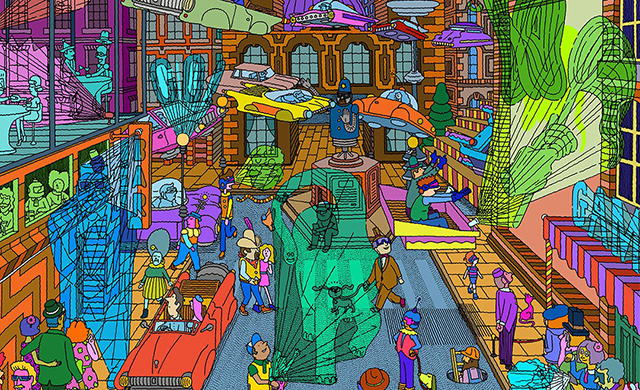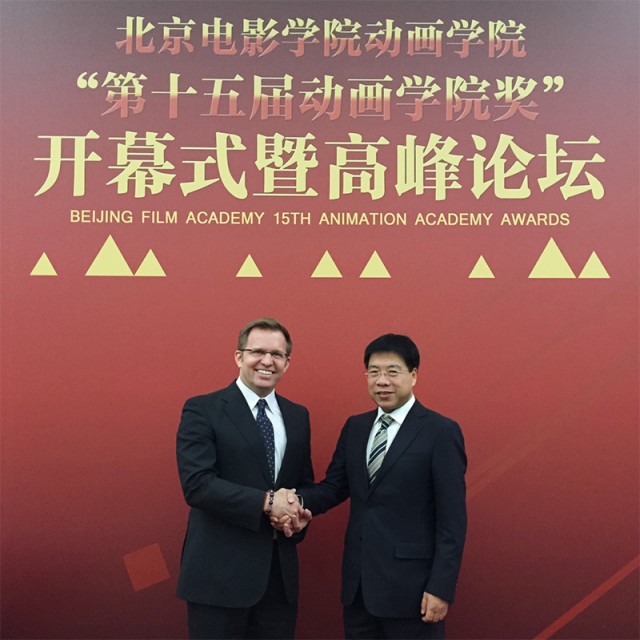This weekend sees the first forum organized by The Beijing Film Academy’s International Animation & Virtual Reality Research Center (iAVRrc). Entitled ‘Future Trends in Stereoscopic Filmmaking and Virtual Reality’, the two-day event will see experts from major entertainment studios, independent startups, hardware companies and academic institutions from China and abroad congregate to discuss immersive entertainment across virtual, augmented and mixed reality. Discussions will focus on the evolution of VR technology, what impact VR may have on the development and production of content and what changes need to take place in education to adapt to the growing importance of immersive media.
The iAVRrc is a new initiative established by the Beijing Film Academy, China’s first film school. The center’s overarching goal is to advance the art of Chinese animated and cinematic storytelling in feature film and new media, including VR and AR content.
Heading up the iAVRrc is Kevin Geiger, CG artist, producer, educator and all round animation creative leader, best known for his fifteen years experience with Disney in California and China. Following eight years in Beijing as the first foreign professor at the BFA’s Animation School and then as VP & Head of Creative for Disney’s China Local Content initiative, Geiger this summer parted ways with Disney, reviving his entertainment company, Magic Dumpling, and forming the iAVRrc to explore the vast possibilities of virtual and augmented reality.
SHP+ caught up with Geiger to talk virtual and augmented reality, China and what’s in store at this weekend’s forum.
本周末,北京电影学院国际动画与虚拟现实研究中心(iAVRrc)将迎来首届论坛。‘立体电影与虚拟现实未来发展趋势’国 际论坛为期两天,来自于国内外大型娱乐工作室、独立创业公司、硬件公司、学术机构的专家们将齐聚一堂,探讨虚拟现实、增强现实和混合现实领域的沉浸式娱乐 产业。他们将着重探讨虚拟现实技术的演变、虚拟现实对内容开发和制作可能会带来的影响,教育应如何改变以适应越来越重要的沉浸式媒体。
iAVRrc是北京电影学院(中国首个电影学院)的全新倡议。该研究中心的首要目标是提升中国动画艺术以及长篇电影和新媒体的电影化叙事,其中就包括虚拟现实和增强现实内容。
iAVRrc由Kevin Geiger牵头,他是一位CG艺术家、制片人、教育工作者,同时也是一位全面的动画创意领袖,在加州和中国迪士尼有着15年的工作经验,并以此被人熟知。他是北京电影学院动画学院的首位外国教授,任教八年,之后担任迪士尼中国副总裁和创意总监,今年夏季,Kevin Geiger离开了迪士尼,重新复苏了他的娱乐公司 – 魔力饺子,之后又创建iAVRrc,探索虚拟现实和增强现实的巨大潜力。
SHP+采访了Kevin Geiger,他讲述了虚拟现实和增强现实,谈到了中国,以及本周末论坛的话题。
Kevin Geiger becomes Executive Director of the iAVRrc during the opening ceremony of the 15th Annual Beijing Film Academy Awards. 第十五届北京电影学院动画学院奖开幕式期间,Kevin Geiger被任命为iAVRrc执行主任
Why was the iAVRrc an interesting project for you personally?
Google’s Spotlight Stories had the same eye-opening effect on me for VR in 2015 as Pixar’s “Luxo Jr.” had on me for CGI almost 30 years ago. My interest in immersive storytelling, virtual reality and augmented reality led me back to my independent creative endeavours here in China, where the market is hot but will quickly cool in the absence of good content. Having spent my career building and running creative teams, I wanted to create an open “laboratory” for immersive content creation in China. Throughout my career, I’ve benefitted from the mentoring and support of others, so I believe it’s an obligation to give something back.
为什么iAVRrc对您个人来说是一个非常有意思的项目?
2015年谷歌Spotlight Stories的虚拟现实技术,就如同30来年前皮克斯的短片《顽皮跳跳灯》的电脑生成动画一样,让我大开眼界。我个人对沉浸式的故事叙述、虚拟现实和增强现实很感兴趣,这也让我在中国回归了独立的创意事业,这些技术目前在中国很火,但是如果没有好内容的话,热情很快就会冷却。我的职业生涯一直都在创建和运营创意团队,所以我想在中国打造一个沉浸式内容创作的开放“实验室”。在我整个职业生涯中,我一直受益于别人对我的指导和支持,所以我相信我有义务回馈他人。
Glen Keane’s ‘Duet’. Duet is a 2014 short film created by Disney animator Glen Keane. The project was done in conjunction with Google’s Advanced Technology and Projects Group as part of Google’s Spotlight Stories. Glen Keane作品《Duet》。《Duet》是迪士尼动画师Glen Keane于2014年创作的动画短片。这是一个和谷歌先进技术和项目研究小组合作打造的项目,是谷歌Spotlight Stories的一部分。
“We’ll soon wonder how we ever lived without VR and AR technology”
“我们很快就会想,以前没有虚拟现实和增强现实技术的时候人们是怎么生活的呢”
How widespread will the use of VR/AR become?
Virtual reality and augmented reality applications are expected to have a ubiquitous presence in people’s lives within the next ten years – in business, home, services and entertainment. We’ll soon wonder how we ever lived without VR and AR technology. The technology finally seems to be reaching a tipping point in which the cumbersome systems of the past are giving way to a genuine consumer electronics business for VR and AR. However, we have yet to reach the point where the average consumer wants to use VR, and even further from the point where the average consumer needs to use it. Those points in time will come, but will require the tech to become sexier and more ephemeral.
The potential for commercial AR applications is believed to be even greater than VR’s remarkable entertainment potential. The biggest area of impact will not be in entertainment but in commerce. Citi Research recently estimated the total VR/AR market as being worth $674 billion by 2025, over $400 billion of which is expected to come from AR commerce, compared to approximately $100 billion expected to come from VR entertainment. Online shopping is already huge, especially in China, and AR apps already exist that let you visualize furnishings in your home or clothes on your body before purchasing, so those estimates may in fact be conservative.
VR and AR wearables will eventually replace smartphones, with commercial opportunities generally divided into a devices & wearables market, and a content & services market. Opportunities and innovation in both markets will be highly disruptive to existing business models.
虚拟现实/增强现实将来的用途有多广?
在未来的十年中,虚拟现实和增强现实的应用将会渗透到人们生活中,无处不在 – 商业、家庭、服务和娱乐。人们很快就会想以前没有虚拟现实和增强现实技术时,我们是怎么生活的。这些技术似乎终于迎来了转折点,过去那些笨重的系统现在终于让步给真正的电子消费品以及拟现实和增强现实。但是,普通消费者想要使用虚拟现实的时刻并未到来,或者进一步来讲,普通消费者需要使用虚拟现实的时刻更没有到来。但是这一时刻迟早会到来,那么首先技术要更性感,更转瞬即逝。
有人认为,增强现实的商业用途潜力要比虚拟现实的娱乐潜力还要大。受影响最大的领域不是娱乐产业,而是商业领域。花旗研究所近期估计,虚拟现实/增强现实总体市场价值在2025年将达到6740亿美元,其中4000多亿美元将来自于增强现实商业领域,相比之下,近1000亿美元将来自于虚拟现实娱乐产业。网上购物规模巨大,在中国尤为如此,增强现实应用软件已经存在,可以让人们在购物之前,可视化地看到家具放在家里是什么样,衣服穿在身上是什么样,如此看来,这样的估值事实上是很保守的数字。
虚拟现实和增强现实可穿戴设备最终会取代智能手机,商机大致可以分为设备和可穿戴市场以及内容和服务市场两大块。这两大市场的机遇和创新将会颠覆现有商业模式。
 London artist Jim Stoten presents his whimsical take on the future of virtual reality and augmented reality. 伦敦艺术家Jim Stoten即兴讲述虚拟现实和增强现实
London artist Jim Stoten presents his whimsical take on the future of virtual reality and augmented reality. 伦敦艺术家Jim Stoten即兴讲述虚拟现实和增强现实
Where does China stand by comparison to the rest of the world in the development of VR and AR?
Despite the blistering pace of technological advancement, China is less of an innovator than it is a fast follower. Chinese businesspeople and investors almost always want to see precedent for something in the West before they commit themselves to it in China. However, once they do commit, it is with an intense focus on being faster and cheaper than their foreign counterparts. Being “better” usually is not part of the initial business model and, frankly, often not necessary.
China also benefits from being a step “behind” in that Chinese players can study Western business models and then leapfrog over those which either didn’t work, or which worked but are now irrelevant – for example, parts of rural China with no movie theaters but high mobile entertainment consumption.
Like most of the world, domestic Chinese companies are very hardware-focused at the moment, with everyone vying to be “the standard”. I smiled when I once heard a foreign speaker refer to the “fragmented” Western VR hardware market, mentioning four foreign VR headset makers as evidence, while in China there are hundreds of such players jockeying for position.
Chinese media companies are just now starting to create content for VR and AR. Most of that activity is in the gaming sector, with emerging efforts in animation and cinema. So far, what passes for “immersive content” is simply shoehorning other media into VR, with little consideration for the compelling new possibilities. In this respect, China is not much different from the rest of the world, where VR is still the “horseless carriage” and has not yet come into its own as the “automobile”.
就虚拟现实和增强现实的发展而言,中国同世界其他地方相比,处于什么样的位置?
虽然中国的技术进步飞速发展,但中国更倾向做一个追随者,而不是创新者。中国商人和投资者在全身心投入任何事情之前,总是想先看看西方是不是有先例。但是,中国人一旦决定全身心投入去做,会不同于不像外国人,他们总是集中精力要做的更快更廉价。“更好”往往不是中国人最初的商业模式,坦白来讲,通常也没这个必要。
处于一步之“遥”的位置,往往对中国来说也是有利的,这样他们就可以学习西方的商业模式,并且跨越那些西方的走不通的地方,或者是跨越那些走得通但是跟现在不相关的地方 – 中国有的农村地区并没有电影院,但是移动娱乐消费却很高。
如同世界上大多数地方一样,中国公司目前都非常注重硬件,人人都争先恐后想成为“标准”。有一次我听到一个外国讲者谈到了“碎片式的”西方虚拟现实硬件市场,提到了四家国外的虚拟现实耳机制造商为例证,对此我只是一笑置之,因为中国有上百家这样的公司相互竞争争取有利位置。
中国媒体公司现在正开始打造虚拟现实和增强现实内容。多数都集中在游戏领域,动漫和电影院也开始了一些尝试。现在,”沉浸式内容“被误认为就是把其他的媒体硬塞进虚拟现实中,并且几乎不用考虑那些全新的不可抗拒的可能性。就这一点而言,中国和世界其他地方没有太多差别,虚拟现实仍旧是“不用马拉的车子”,并没有真正成为“汽车”。
Tell us about the iAVRrc’s story incubator?
I’ve spent the past eight years in China – including three with Disney – dedicated to story development. Good story lies at the heart of every medium, but what that constitutes varies greatly from medium to medium, as anyone who has tried to adapt a novel to a screenplay can attest. Despite Ed Catmull’s contrarian opinion at the recent Web Summit in Dublin, virtual reality is indeed a storytelling medium – potentially the most compelling to date. But it comes with its own set of ground rules that are being figured out as we speak by folks like Saschka Unseld, who left Pixar to helm Oculus Story Studio. The iAVRrc’s story incubator is intended to help Chinese creatives adapt their own experience to the limitless possibilities of virtual reality and augmented reality content creation.
跟我们说说iAVRrc故事孵化器吧?
我在中国已经待了八年,其中有三年在迪士尼工作,一直都致力于故事开发。好的故事是任何一个媒介的核心,但是不同媒介之间大相径庭,任何一个曾经尝试过将小说改变成剧本的人都可以证明这一点。尽管Ed Catmull最近在都柏林举办的Web Summit上的看法与我们的看法背道而驰,但是事实上虚拟现实也是一种讲故事的媒介 – 而且潜在来讲可能是迄今最具有说服力的媒介。但是它也有自己的一套基本规则,Saschka Unseld等人现在正在试图找到这些基本规则,Saschka Unseld离开皮克斯后来到了Oculus的Story Studio。iAVRrc故事孵化器意在帮助中国创意人员将自身的经验应用到虚拟现实和增强现实内容创作方面,释放其无限可能。
Saschka Unseld, Creative Director, Oculus Story Studio. Saschka Unseld,Oculus故事工作室创意总监
The Beijing Film Academy’s International Animation & Virtual Reality Research Center (iAVRrc)’s ‘Future Trends in Stereoscopic Filmmaking and Virtual Reality’
- Venue: The BUPT Hotel, Haidian District
- Saturday December 12th and Sunday December 13th
- This is an invitation-only event.
北京电影学院国际动画与虚拟现实研究中心(iAVRrc)‘立体电影与虚拟现实未来发展趋势’国际论坛
- 地址:北京市海淀区 北邮科技酒店
- 时间:2015年12月12日(周六)13日(周日)
- 此活动仅限受邀人员参加






 BAM Music Library Brings Edgy, Indie Sounds to Chinese Creatives
BAM Music Library Brings Edgy, Indie Sounds to Chinese Creatives
